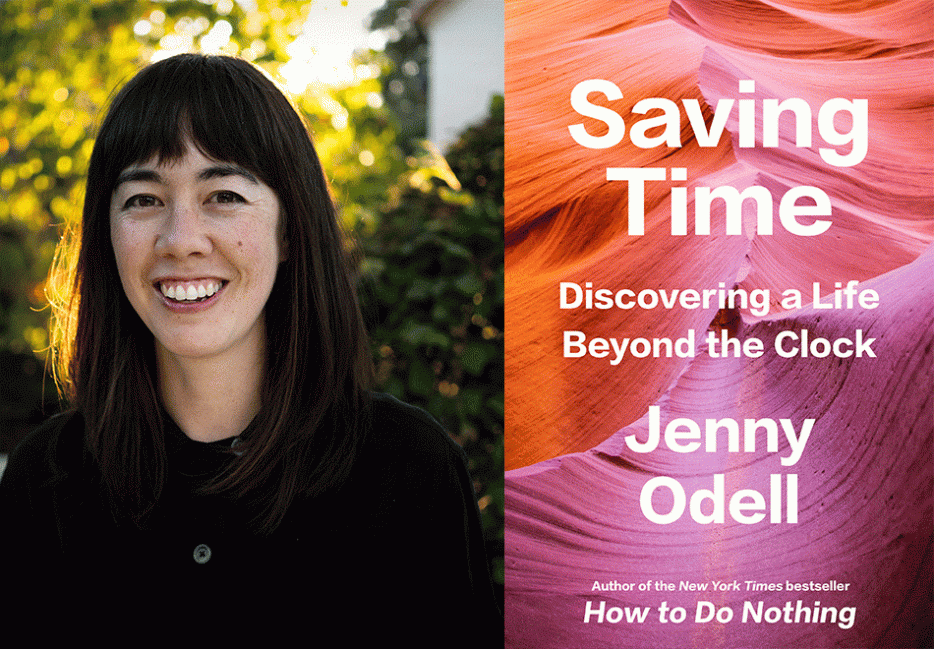My Instagram page is an ocean of calm. Thousand-piece jigsaw puzzles. Slow mornings with tea and cats. Pictures of the books I’m reading set against tropical greenery. The pace is patient and soft—a direct response to a life deeply altered by chronic fatigue, in which the fast became the impossible, and posting about slowness became a way for me to grapple with the loss. It also became an expression of my politics: the less “productive” I was, the closer I felt to the anti-capitalist resistance that used to have me marching nearly every week. Once a Marxist in the streets now a Marxist in the sheets, right?
Not exactly, as it turns out.
In her book Saving Time: Discovering a Life Beyond the Clock (Random House), artist and author Jenny Odell writes: “On Instagram, posts about slowness, self-care and ‘taking time out’ [act as] advertisements. [T]hey read either implicitly or explicitly as exhortations to the viewer: You, too, could (should) be this slow!” Here, a leisurely pace is simply another facet of the experience economy, something to be bought in service of the good life. “[S]eeking new ways of being,” Odell writes, “I find only new ways of spending.”
At a time when income inequality is rapidly worsening, what does it mean for privileged people to react to burnout by “fortifying walled gardens of slowness, minimalism and authenticity”—an aspiration that is far removed from most people’s options and lives?
In many ways, Saving Time is an answer to this question. From how the “slowness” of the privileged is made possible by the speeding-up of others to why resisting the climate crisis involves a rejection of uniform clock time, Odell’s follow-up to 2019’s How to Do Nothing establishes her as a leading philosopher of our age. Within these pages we encounter factory lines, automation, trees, leisure, moss, disability, art: a vast array of histories, experiences and realities that lead us to a world in which time isn’t running out, as we’re so often made to feel.
And what of slowness? Odell suggests a slowing down that has nothing to do with consumerism. Rather, it is a matter of attention, of noticing “simply what has been happening all along, just outside [our] perception.” At this pace, time expands outwards, not forwards, calling our awareness towards the lives of both human and nonhuman beings—a path towards collective wellbeing that is not predicated on possessing a front garden in which to rest your lovely teacup.
Odell writes: “What consumers do is buy green, not hold each other and cry.” Saving Time asks what could happen within our lives, within our time, if we were able to do the latter instead.
Richa Kaul Padte: I’d love to start by talking about our “unhealthy fixation on morning routines.” You’re referring to the extreme self-optimization of productivity bros, but lately I’ve begun to feel that even “healthier” morning routines—morning pages, meditation trackers—stem from the same place: a desire “to see time…as something we [can] cut up, stack, and move around.” Routines focussed on self-improvement purport to help us use our time well. In contrast, you later cite sociologist Richard Sennett, who observes that “routine can demean, but it can also protect…it can compose a life.” What distinguishes this second type of routine from the first?
Jenny Odell: I think the difference has to do with the reasoning behind a routine. For example, a traditional ritual, where different things are done in a certain order for a certain length of time; the goal in some cases [here] is to feel connected to the past or be reminded of specific values. A routine or a ritual may simply be a recipe for what an individual or a society has decided is the best, most beautiful, or most meaningful way to do something. The kind of problem you’re describing shows up with routines in which the goal, out of all these possibilities, is the squeezing of some (narrowly defined) value out of each minute. The hallmark of this kind of goal is quantification, as a well as an overall punitive feeling that has more than a whiff of industrialism and the Protestant work ethic.
The danger is that you can get so caught up with measuring, rewarding, and punishing yourself that you never get to step back and ask that broader question about what the routine is for. And of course, it plays right into the overall cultural idea of individuals with time in their individual time banks—not ideal if you’re trying to see the world in terms of support, solidarity, and mutual care.
The idea of robots coming for our jobs has been a fear for a long time, but the reality is less about machines taking over factory lines and more about “the social relations within which [machines] are employed.” There was recently a conversation online about the way this has affected translators, who are often now paid to edit documents that have been run through Google Translate or other AI—a tedious, frustrating process that’s as lengthy as translation, but for which they are paid much less (the so-called real work has already been done by AI, or so employers claim). Is it robots or capitalism coming for our jobs?
Your example gels so well with a book I cite, Gavin Mueller’s Breaking Things at Work: The Luddites Are Right About Why You Hate Your Job. I really appreciate that book for the way Mueller situate[es] current conversations about automation within the longer history of work and technology. All throughout this history, you see that machines and automation don’t so much replace work as reorganize it; so while it may not be accurate to say “robots are coming for our jobs,” you could still certainly say “robots are going to affect our jobs.” And as long as the goal of work is to make a profit, the way that they affect jobs has often been to make the work of humans duller, less well-paid, and more geographically far-flung. In so doing, it also intensifies that work, pitting workers against each other, automated systems, and the clock. Emily Guendelsberger, whose book On the Clock I also cite, gives such a visceral description of working in an Amazon warehouse, in which her movements are dictated by her own scanner gun and she “compete[s] with computers, algorithms, and robots that never get tired, or sick, or depressed, or need a day off.”
You write: “the implied answer to the question ‘who will do the low-wage work’ is that it doesn’t matter, as long as it’s not you.” As you go on to say, “some people’s time is not only valued less, but also understood as existing for the sake of others’ time.” To ask your own question back to you: “Who gets to occupy time and who (and what) does not”?
There seems to be this idea that some types of activity achieve changes and progress in the world (e.g. salaried work), and others don’t (e.g. caretaking). One appears to be going forward in time and the other appears to be going in circles—if it appears at all. This difference is reflected both in how society values each type of work—literally, in terms of wages, but it also shows up less literally in the way that certain tempos are privileged. Someone’s schedule is always more important. Some people are expected to rush or wait for others, like stagehands running around in the background so the real show can go on.
The structure that defines whether someone is considered an “actor” here is the same as that which governs power imbalances in general: it is typically an able-bodied, white, male, cis temporality that is given priority. It makes me think of this brutal opening monologue in the 1998 film A Civil Action, where a cynical personal injury lawyer is describing the chances of winning a trial on behalf of an injured or deceased plaintiff: “A dead adult in his 20s is generally worth less than one who is middle-aged, a dead woman less than a dead man, a single adult less than one who is married, Black less than white, poor less than rich. The perfect victim is a white male professional, 40 years old, at the height of his earning power, struck down in his prime.”
At the same time, I want to point out the parenthetical who (and what) in my own question. There is a broader historical version of what I’m describing, in which Western colonial powers encountered places and people they considered to be existing without time. It was as if the timeline didn’t start until they arrived, and their linear, quantified time was given priority over existing Indigenous conceptions of time. An important part of this clash is the notion that only humans occupy time and that everything else is just sort of existing, again, in that cyclical way—an environment made of automata, not actors. That is the very attitude that has contributed so much to our current climate crisis, in that it frames so much of the world as things to be mined and exploited to death. What’s interesting is that in both of these scenarios I’ve described, to occupy time means to be something closer to a subject. To be left out of time is to be something closer to an object.
Jenny, it feels like every time I’m interviewing you, I’m undergoing a massive chronic illness reckoning! Your first book, How to Do Nothing, held me closely in 2019, so I was really pleased to see the space you afford to illness and disability in Saving Time. In particular, crip time—“the tension between a disabled person’s temporality and the clock-based, industrialized timetables of modern-day society.” While at one level this is a question of disabled people’s agency (we don’t all have the same number of Beyoncé hours in a day!), it is also, in associate professor of feminist studies Alison Kafer’s words, a “reimagining of our notions of what could and should happen in time.” How does crip time expand possibilities for everyone?
A really beautiful illustration of this expansion is in Sara Hendren’s book, What Can a Body Do?, where she talks about her relationship with her son, diagnosed with Down’s syndrome at birth. There are obviously challenges, which Hendren notices often have to do with time and being out of sync with how value and progress are usually framed. But she also describes it as a gift: it’s through observing and interacting with her son that she can begin to see a different framing, one where a person can be something more than a receptacle of potential work, and where joy and meaning are the desired outcomes.
This is the same gift I feel that crip time gives to all of us: it is a real, embodied demonstration of a value system that is different from the one that—whether or not you’re disabled—constricts so much of the human experience. It provides a standpoint from which we can consider things about the shape of time that especially able-bodied people may have taken for granted, and I find that it’s often the things that we take for granted that hurt us the most.
When you think about who is actually comfortable in “clock-based, industrial timetables,” you start to realize how narrow it is—not just in terms of disability, but also, for instance, in terms of age. I really feel that there is so much of us that exists at odds with, or between the margins of, the unforgiving timetable world and the values it espouses. Crip time shows us that it doesn’t have to be that way.
Ideas about having a good life usually go in two directions: extending your life via so-called wellness and fitness, and/or juicing the crap out of the short life you have (travel the world! Skydive!). As someone with chronic illness, these both feel like options where I’m set up to fail. But as I get older, I realize that everyone’s life is circumscribed in a variety of ways that mean one or both of these strategies will invariably fall short. You offer a more freeing alternative: “Maybe ‘the point’ isn’t to live more…but rather, to be more alive in any given moment—a movement outward and across, rather than shooting forward.” How is this type of living in the moment different from carpe diem in the action-packed sense we usually understand it?
For me the difference has to do with how you define an individual, or how much weight you place on the currently dominant notion of an individual. Juicing the crap out of the short life you have is what you do when you see yourself or your life as a product that you need to get the most value out of—even better if you can get more value out of it than your neighbour gets out of theirs. When I talk about being “more alive,” I’m describing a relationship—between myself and another person, myself and a bird, or myself and an entire place, for example.
I feel more alive when I’m really there with that other, in a way that can sometimes erase the clock, replacing my time with our time. And I think it’s pretty intuitive, this idea of building bridges across rather than accruing to oneself. When you look back at the moments in your life that you associate with meaning (vs. “success”), they might not have been straightforwardly happy or comfortable, but I’m guessing they involved some kind of especially resonant moment with something or someone outside of yourself, and that they might have changed you for good. For me, being receptive to such a feeling is part of what I mean by being more alive.
You talk about the need for “not just biodiversity but...chronodiversity,” which is linked, as you write elsewhere, to “a less human-centric model of who and what is owed respect and justice.” How are nonhuman conceptions of time, such as moss time, connected to justice?
There’s a part of Robin Wall Kimmerer’s Gathering Moss that I really love, where she describes having to adjust her studies to the moss itself. She says, “Rather than looking at the clump as an entity, I had to recognize that the clump was simply an arbitrary unit that was convenient for me, but had little meaning for the moss. Mosses experience the world as individual stems and to understand their lives I needed to make my observations at the same scale.”
Taking seriously the idea that time is as real for the nonhuman world as it is for humans means admitting that nonhumans have experience, which is the beginning of the idea that they also deserve rights. As current “rights of nature” campaigns illustrate, this requires empathy, imagination, and I think also a reckoning with the history of why and how we divide the world into human and nonhuman.
To go back to what I said earlier about who (and what) gets to occupy time, in the book I cite the theorist Sylvia Wynter, who has written about how [the] very narrow definition of “Man” in the idea “Man vs. Nature” arose out of a specific historical moment: the point of contact between Western colonial powers and the people and lands they sought to exploit and exclude from historical time. Nature here would’ve included not just the local ecology but colonized people, similarly framed as resources. This divide went on to affect who and what are considered subjects as opposed to objects, as we can see so clearly in the history of slavery in the U.S. and the absurd compromise of the three-fifths rule.
What was interesting for me to learn was how historically specific that distinction was—subject/object, in time/not in time, foreground/background—and to see how much it spills into the modern day: not just in how different peoples’ time is valued, but in how the nonhuman world, which is certainly changing, is still rarely figured as having actors in it. That has to change, and is part of why I titled my climate change chapter “A Change of Subject.” I agree with the environmentalists, in particular Indigenous activists, who argue that a real response to the climate crisis would have to address this issue of cultural perception.
Part of seeing time as something we use involves seeing ourselves as separate from time. But you advocate, instead, for an understanding in which all beings—including those we presume to be inanimate, like rocks—are constantly being inscribed by time. Can you talk more about what this means? It reminds me of Donna Haraway’s concept becoming-with, where everything exists “in thick co-presence” with everything else.
For me, I think of Henri Bergson, the philosopher that I rely on quite heavily in this book, and his description of walking past the buildings of a familiar town: “Like myself they have lived, and like myself they have grown old.” I honestly find myself thinking about that line all the time. Sometimes I imagine perception as a windshield that can get dirty with all kinds of things like petty worries, self-absorption, and impatience. But on good days, when the windshield is especially clean, I feel not only that I can see everything but that everything is there with me, that the world is present and I am present in the world. I can go to the park, full of trees, birds, and rocks, and feel co-present with them, seeing that “like myself they have lived.” I find that it is a much less lonely existence.
In the book I describe a buckeye tree in a local park: all of the different stages it goes through and its fall and winter dormancy. At the beginning of this year, I had COVID and was quarantined in my room, and when it happened, the tree was still dormant, with little buds on the ends of the branches just waiting. Then when I came out of quarantine and finally went for a walk, I was surprised to find that the clock had skipped ahead while I was inside: perhaps because of the massive amount of rain we got, the buds had not only opened but the leaves had already escaped. What was really surprising to me, though, was how genuinely overjoyed I felt. I think I literally threw my arms out to the side, and the look on my face was the same exact one you would have if you hadn’t seen a friend since last year.






